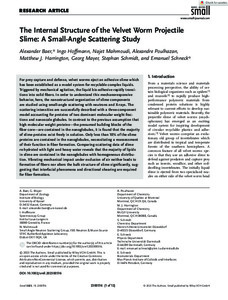| dc.date.accessioned | 2023-07-31T13:13:00Z | |
| dc.date.available | 2023-07-31T13:13:00Z | |
| dc.date.issued | 2023-02-24 | |
| dc.identifier | doi:10.17170/kobra-202307218451 | |
| dc.identifier.uri | http://hdl.handle.net/123456789/14954 | |
| dc.description.sponsorship | Gefördert im Rahmen des Projekts DEAL | ger |
| dc.language.iso | eng | |
| dc.rights | Namensnennung-Nicht-kommerziell 4.0 International | * |
| dc.rights.uri | http://creativecommons.org/licenses/by-nc/4.0/ | * |
| dc.subject | biopolymers | eng |
| dc.subject | mechano-responsive | eng |
| dc.subject | neutron scattering | eng |
| dc.subject | onychophora | eng |
| dc.subject | SDS-PAGE | eng |
| dc.subject | X-ray scattering | eng |
| dc.subject.ddc | 570 | |
| dc.subject.ddc | 590 | |
| dc.title | The Internal Structure of the Velvet Worm Projectile Slime: A Small-Angle Scattering Study | eng |
| dc.type | Aufsatz | |
| dcterms.abstract | For prey capture and defense, velvet worms eject an adhesive slime which has been established as a model system for recyclable complex liquids. Triggered by mechanical agitation, the liquid bio-adhesive rapidly transitions into solid fibers. In order to understand this mechanoresponsive behavior, here, the nanostructural organization of slime components are studied using small-angle scattering with neutrons and X-rays. The scattering intensities are successfully described with a three-component model accounting for proteins of two dominant molecular weight fractions and nanoscale globules. In contrast to the previous assumption that high molecular weight proteins—the presumed building blocks of the fiber core—are contained in the nanoglobules, it is found that the majority of slime proteins exist freely in solution. Only less than 10% of the slime proteins are contained in the nanoglobules, necessitating a reassessment of their function in fiber formation. Comparing scattering data of slime re-hydrated with light and heavy water reveals that the majority of lipids in slime are contained in the nanoglobules with homogeneous distribution. Vibrating mechanical impact under exclusion of air neither leads to formation of fibers nor alters the bulk structure of slime significantly, suggesting that interfacial phenomena and directional shearing are required for fiber formation. | eng |
| dcterms.accessRights | open access | |
| dcterms.creator | Bär, Alexander | |
| dcterms.creator | Hoffmann, Ingo | |
| dcterms.creator | Mahmoudi, Najet | |
| dcterms.creator | Poulharan, Alexandre | |
| dcterms.creator | Harrington, Matthew James | |
| dcterms.creator | Mayer, Georg | |
| dcterms.creator | Schmidt, Stephan | |
| dcterms.creator | Schneck, Emanuel | |
| dc.relation.doi | doi:10.1002/smll.202300516 | |
| dc.relation.projectid | MA4147/7-1, MA4147/7-2, SCHM 2748/5-1, SFB 1208, project Z02, Emmy-Noether grant SCHN 1396/1 | |
| dc.subject.swd | Biopolymere | ger |
| dc.subject.swd | Stummelfüßer | ger |
| dc.subject.swd | Schleim | ger |
| dc.subject.swd | Neutronenstreuung | ger |
| dc.subject.swd | Röntgenstreuung | ger |
| dc.subject.swd | Nanostruktur | ger |
| dc.type.version | publishedVersion | |
| dcterms.source.identifier | eissn:1613-6829 | |
| dcterms.source.issue | Issue 22 | |
| dcterms.source.journal | Small | eng |
| dcterms.source.volume | Volume 19 | |
| kup.iskup | false | |
| dcterms.source.articlenumber | 2300516 | |


